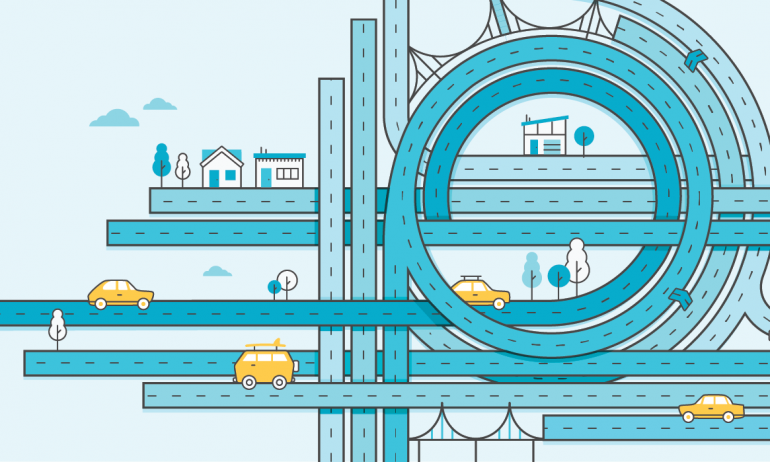Many or all of the products featured here are from our partners who compensate us. This influences which products we write about and where and how the product appears on a page. However, this does not influence our evaluations. Our opinions are our own. Here is a list of our partners and here's how we make money.
Driving has long been central to American culture, and we’re on the road now more than ever: We drive over 3 trillion miles each year, and that number keeps going up, according to the U.S. Department of Transportation. Add to those numbers the increasing dangers of distracted driving and you have a mix that is resulting in more car accidents — and more deaths.
To examine the state of driving in the U.S., NerdWallet used industry data sources to analyze costs associated with driving. We also commissioned a survey of over 2,000 U.S. adults conducted online by Harris Poll to learn more about the nation’s drivers. See the methodologies at the end of this report for details about our analysis and the survey.

See what you could save on car insurance
Easily compare personalized rates to see how much switching car insurance could save you.Key findings
Good drivers could be missing out on saving $416.52 a year, on average nationwide, by not shopping around for car insurance, NerdWallet’s analysis found. Residents of Delaware, Michigan and Connecticut stand to lose out on the most money, up to $1,845.59 annually on average.
38% of Americans who have car insurance haven’t checked the price, or compared costs, of their current car insurance in at least three years (or ever), according to our survey.
Consumers and insurers pay a high price for auto insurance fraud due to padded claims, which totaled nearly $6 billion for bodily injury and personal injury protection claims in 2013, according to NerdWallet’s analysis of the most-recent industry data.
10% of Americans who have ever had car insurance admit to intentionally providing inaccurate information when purchasing a new car insurance policy, our survey found.
Of Americans in our survey who have driven in the past 12 months, 67% have used a cell phone while driving during that time. That behavior can lead to death: The most-recent data show that 10% of fatal crashes involved distracted driving in 2015, and the driver was using a cell phone in 14% of those, according to the Department of Transportation.
Americans are missing out on car insurance savings
NerdWallet’s analysis shows that drivers without tickets or violations may be missing out on saving $416.52 a year, on average nationwide, by failing to compare car insurance.
In addition, 38% of Americans who currently have car insurance say that they haven’t price checked their insurance by comparing it with quotes from other companies in at least three years (or ever), the survey found. More than 1 in 5 (21%) haven’t checked in at least three years and 17% haven’t checked at all.
But over a quarter (28%) of Americans who currently have car insurance think they pay too much for it. Among those who currently have car insurance, our survey found that:
1 in 3 millennials (33% of those ages 18-34) think they pay too much for it. They are also least likely to have compared insurance quotes: 26% of these younger adults say they’ve never price checked car insurance, compared with 14% of adults ages 35 and older. Out of all adults, 17% say they’ve never price checked their insurance.
Americans whose annual household income is $50,000 to $74,999 are more likely (37%) to think they are paying too much for their car insurance than those (24%) whose annual household income is $75,000 or higher.
When to compare quotes on insurance
Shopping around for car insurance can pay off because of the complicated ways insurers determine rates. In addition to factors you might expect — like driving history and your car — your credit, where you live, your age and other factors play a role. And each insurer calculates rates differently.
Auto insurers routinely raise prices when policies are renewed, which is typically every six months or yearly. It’s wise to check insurance quotes regularly to see if you’re getting a good price. In addition, compare rates when you:
Add or remove vehicles on your policy.
Add or remove drivers.
Have a life change such as marriage, job switch or retirement.
Move to a new ZIP code.
Click your state to find the cheapest car insurance there | ||
|---|---|---|
The lies told to auto insurers
One in 10 Americans who have ever had car insurance (10%) have lied about their personal or vehicle information when purchasing a new policy, our survey found. People ages 18-34 are twice as likely as those 35 and older to mislead insurers (16% vs. 8%), and men are more likely to mislead insurers than women (12% vs. 7%).
Misleading insurers can backfire: If you get into an accident and your insurer discovers your application had false information, the company could deny your claim.

See what you could save on car insurance
Easily compare personalized rates to see how much switching car insurance could save you.Drivers are inflating insurance claims
While some consumers think they pay too much for car insurance, others may think little of padding claims by overstating damage or injuries. The extra money they get from claim payments is either swallowed by insurers or passed on to the rest of us in the form of higher insurance rates.
Nearly a quarter (23%) of Americans who have ever had car insurance say they’ve filed a claim, according to our survey. Among them, 7% admit to padding auto insurance claims by doing one or more of the following:
Adding more damage to the car for the claim.
Misstating the cause of a car accident.
Including pre-existing damage in a claim.
Overstating repair costs.
Exaggerating the extent of pain or personal injuries.
States with the highest padded-claims costs
Nationally, auto insurance fraud due to padded claims for bodily injury and personal injury protection cost insurers and consumers $5.88 billion in 2013, the most-recent year for which data are available, NerdWallet’s analysis found.
In general, padded-claims costs are higher in heavily populated states. More drivers and denser populations make for a higher number of auto insurance claims — and more opportunities for fraud.
Deaths and driving distractions
Preliminary crash data for 2016 indicate that motor-vehicle deaths increased 6% from a year earlier, according to the National Safety Council. Total crashes increased every year from 2011 to 2015, with 958,000 more crashes in 2015 than in 2011, according to the Department of Transportation.
Distracted driving is also on the rise — and it costs us more than money. According to the Department of Transportation, 10% of all fatal traffic crashes in 2015 involved distracted driving.
And a majority (67%) of the Americans who have driven in the past 12 months used a cell phone while driving during that time, NerdWallet's survey found.
Of the 35,092 people who died in car accidents nationwide in 2015, 3,477 were killed in crashes involving distracted drivers, according to the most-recent federal data. Nine percent of distracted drivers in these fatal crashes were teenagers ages 15 to 19.
To address cell phone use by drivers, 46 states and Washington, D.C., have banned texting and 14 states and Washington, D.C., have banned talking on a phone (other than hands-free) while driving, according to the National Conference of State Legislatures. If you find it’s difficult to ignore your phone in the car, try tossing it in the back seat before you start driving.
The consequences: Weaving and crashing
These days, distracted driving seems to be the norm. Among those who have used a cell phone while driving in the past 12 months, about 1 in 8 (13%) admit that when they were using a cell phone they weaved in and out of lanes, almost went off the road, nearly got into an accident or got into an accident. Nearly 1 in 5 millennials (18%) admitted these occurred.
Driving distracted endangers not only those in a car, but also pedestrians and bikers. The most-recent data from 2015 show that 551 people not in cars were killed by distracted drivers, according to the Department of Transportation.
On a similar note...

